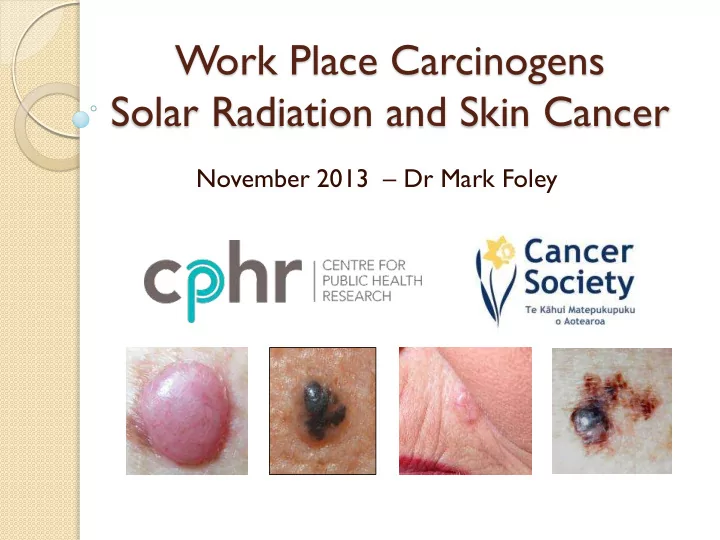

Work Place Carcinogens Solar Radiation and Skin Cancer November 2013 – Dr Mark Foley
Overview Work place carcinogens and skin cancer Who is a risk? Screening and Self skin exam Common skin cancers
Many work place hazards that cause Skin Cancer Solar radiation UV radiation from welders Tar (coal, soot, mineral oils) Arsenic The Skin Clinic Marlborough
Sun exposure is a work place carcinogen The Skin Clinic Marlborough
Who is at risk? The Skin Clinic Marlborough
The Skin Clinic Marlborough
Who is at risk? Every outdoor worker ◦ Especially fair skin and poor protection The Skin Clinic Marlborough
Office worker on lunch break The Skin Clinic Marlborough
Office worker on lunch break Fair skin and poor protection ! The Skin Clinic Marlborough
Who is at risk? Every outdoor worker ◦ Especially fair skin and poor protection ◦ Sun burns and total UV exposure Potentially every indoor worker ◦ Pattern of sun exposure – work and home ◦ ? UVA The Skin Clinic Marlborough
Who is at risk? Every outdoor worker ◦ Especially fair skin and poor protection ◦ Sun burns and total UV exposure Potentially every indoor worker ◦ Pattern of sun exposure – work and home ◦ ? UVA Retired out door workers ◦ Lag time from exposure to development The Skin Clinic Marlborough
So every worker with poor UV protection is at risk …..not just during their working life but a life-long risk which becomes greater in later life.. The Skin Clinic Marlborough
Skin checks Every worker should be taught and preform regular self examination Regular skin checks for outdoor workers, especially those with fair skin and or poor protection. Clinician: Knowledge of vast variation in skin cancer presentation. Check head to toe, not just sun exposed skin. Ideally with dermatoscopy. The Skin Clinic Marlborough
The Skin Clinic Marlborough
Why is sun exposure a work place carcinogen ? Chronic sun exposure ◦ Sun damage – Actinic Keratosis ◦ SCC ◦ Lentigo maligna The Skin Clinic Marlborough
Why is sun exposure a work place carcinogen ? Chronic sun exposure ◦ Sun damage – Actinic Keratosis ◦ SCC ◦ Lentigo maligna Intermittent sun exposure ◦ Melanomas ◦ BCC The Skin Clinic Marlborough
The Skin Clinic Marlborough
Common Skin Cancers The Skin Clinic Marlborough
Reminder of epidermal structure UVB UVA The Skin Clinic Marlborough
The Skin Clinic Marlborough
Epidermis Dermis Fat The Skin Clinic Marlborough
The Skin Clinic Marlborough
BCC The Skin Clinic Marlborough
Melanoma The Skin Clinic Marlborough
AK/SCCi/SCC The Skin Clinic Marlborough
AK/SCCi/SCC BCC Melanoma The Skin Clinic Marlborough
Where do they occur The Skin Clinic Marlborough
The Skin Clinic Marlborough
The Skin Clinic Marlborough
The Skin Clinic Marlborough
The Skin Clinic Marlborough
When do they occur? BCC’s, SCC’s and Melanoma risk all increases with age Different onset ages. The Skin Clinic Marlborough
Melanoma – Age specific rates The Skin Clinic Marlborough
The Skin Clinic Marlborough
Basal Cell Carcinoma Squamous Cell Carcinoma The Skin Clinic Marlborough
BCC’s ◦ common in under 35 ◦ Dramatic increased rate 35+ ◦ Intermittent sun exposure ◦ Mainly sun exposed sites The Skin Clinic Marlborough
SCC’s ◦ Uncommon under 40 ◦ Dramatic increase in 50’s ◦ Chronic sun exposure ◦ Sun exposed sites The Skin Clinic Marlborough
Melanoma ◦ Rare under 14 yrs age ◦ Dramatic increase 50’s ◦ Intermittent sun exposure ◦ Sun protected sites The Skin Clinic Marlborough
So Far UV light damages DNA , if not repaired this is one factor in causing skin cancer Different age and body site profiles Work sun exposure is a significant risk factor. Long lead time from exposure to development of sun damage and skin cancer. The Skin Clinic Marlborough
Solar induced DNA damage & gene suppression Implications for prevention ◦ Minimisation of sun exposure to reduce life time accumulation of UV radiation. Implications for surveillance ◦ Risk extends well beyond leaving a job or retiring
Skin Cancers - clinical The Skin Clinic Marlborough
Solar Keratosis / Actinic Keratosis Sun damage, “sun spots” Considered Pre-malignant
Epidermis AK – lower 1/3 SCCi SCCi – full thickness AK
AK and SCCi therefore have similar naked eye features Different dermatoscopy features
Recommend
More recommend